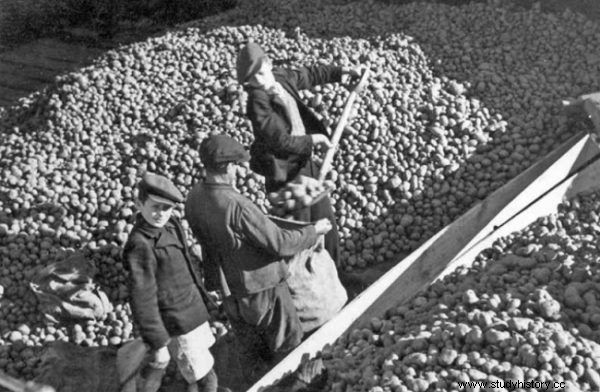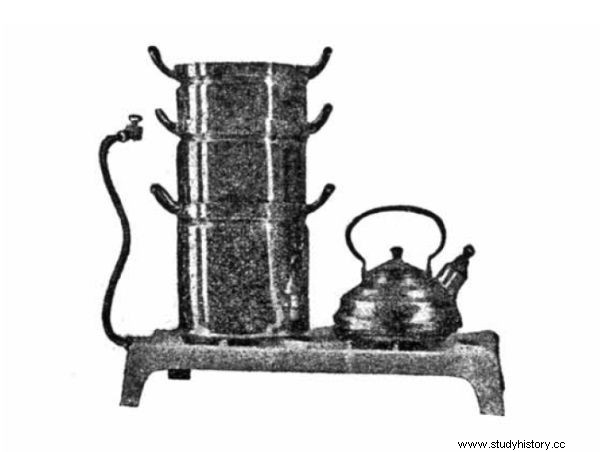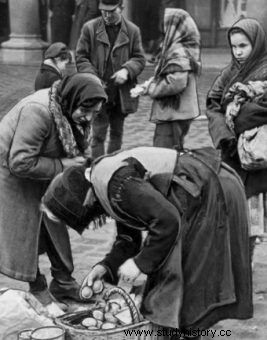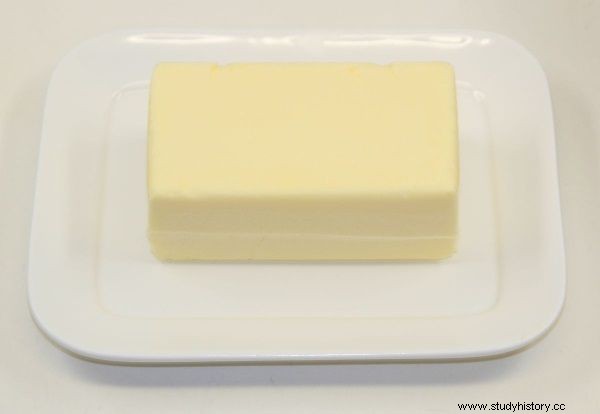Stove broke, fridge won't start and family budget is crackling at the seams? Don't worry, we have a few of our grandmothers' methods for you, which will be perfect on such a doomsday. Everything thoroughly tested "for German".
During the occupation, every housewife had to work out methods of rational buying and storing such valuable food. Thanks to good planning, she was able to save a lot, while protecting herself against dishonesty of store owners.
Don't let anything go to waste!
During the war, the lady of the house was able to use up everything, including kitchen waste. In the realities of the occupation, you had to think twice about what is edible and what is not. The use of dumplings, for example, is water from cooking dumplings. Containing starch and already salted, it could be used as a slightly thickened base for soups, for watering vegetables or as a linen starch. 
It was the same with the bread crusts. In many houses, the hard skins were cut from the sandwiches and thrown away. In the reality of the occupation, even a crumb could not be wasted. Instead of getting rid of them, they were turned into bread soup, rubbed on a grater and used for breading, or instead of flour, they were thickened with sauces.
Even the milk washes were not wasted. The housewives used them in two ways. They gently watered boiling groats or rice with them.

Sometimes there were a lot of potatoes, other times even the last peelings had to be used up.
They also used small amounts of milk to… care for their skin, washing their face with it.
In these difficult conditions, not all women could afford cosmetics, so like their grandmothers or great-grandmothers, they looked for them in ... the kitchen.
Always plan your purchases
Frequent buying of small portions, such as flour or groats, ultimately resulted in purchasing less of them at an inflated price.
The sellers poured these products in the store into paper bags made of thick, heavy paper, generously plastered with glue, to which the dishonest even sprinkled sand for additional weight.
All this to limit the content of "sugar in sugar", and more specifically sugar per kilogram.
The resourceful housewife bought her kitchen ingredients only a few times a year. Always in larger quantities and always paying close attention to current prices.
Love the stale bread
Purchasing, storing, and sorting out bread was an art of sorts. The tastiest, of course, is the fresh one, and the least efficient at the same time. Fragrant and crunchy pajamas are very slow to satisfy hunger, so more of them are eaten.
Therefore, Bolesława Kawecka-Starmachowa recommended buying bread once or at most twice a week and storing it in a tightly closed container so that it would not dry out. The slightly stale bread, in her opinion, was "much healthier and better cut, more economical than fresh" . The same was true for bread rolls intended for work or school sandwiches.

Stackable cooking was one way of saving.
From today's perspective, such an approach may seem exotic. Bread bought in a regular store turns rubbery a day after baking, and two-day-old rolls from the supermarket are barely chewing. However, it should be remembered that bread baked using the old methods, with leaven or yeast, without improvers and preservatives, even for a few days tastes delicious.
What to do when the refrigerator breaks down
In a situation of constant shortage of meat, any more of it was like a blessing. Even if a chunk of hog happened in the middle of a hot summer, the housewife had to somehow keep it from going bad.
The refrigerators kept cool thanks to the chunks of ice had few households, and the first electric coolers were fabulously expensive and reliant on constantly interrupted electricity supplies.

If you managed to get a large piece of butter at the market, you had to do your best not to spoil it.
The easiest way to store meat was to divide and preserve it rationally and economically. A piece of soup was poured over with boiled salted water and put aside in a cool place.
When it came time to prepare the soup, it was enough to add vegetables and spices to the same pot and cook it. Meat intended for baking could be preserved by frying it in fat or marinating in vinegar. When browned in a pan, it could stay in a cool place for up to three days, and drowned in vinegar for up to a week.
Preserving-free
Butter, which most often appeared in the occupation kitchen thanks to a black market transaction or smuggling expedition, usually appeared in larger pieces. It was several dozen decagrams or a kilogram, so much more than we bring today from stores in the form of cubes or whetstones.
Despite the lack of refrigerators, they could be stored without the risk of becoming rancid for up to several weeks. They were preserved, usually by dipping them in brine, or, kneaded in a pot, covered with moist parchment and covered with salt.
Also other animal fats have been preserved in a way that does not change their taste and smell for a long time. After melting, the lard was poured into dry, scalded bottles and tightly corked.

If a piece of butter will not fit in the fridge, you can always store it outside in brine. (photo published under CCA SA 3.0 license, author Lionel Allorge)
It was best to cut the lard into pieces that could be used whole (a few grammes), salt it well and keep it in a tightly tied stone pot.
When the lady of the house needed to garnish dumplings or potatoes with bacon, she took out a piece, diced it, fried it and poured it with grease and pork scratchings.
***
The article was based on materials collected by the author while writing the book "Occupation from the kitchen".
